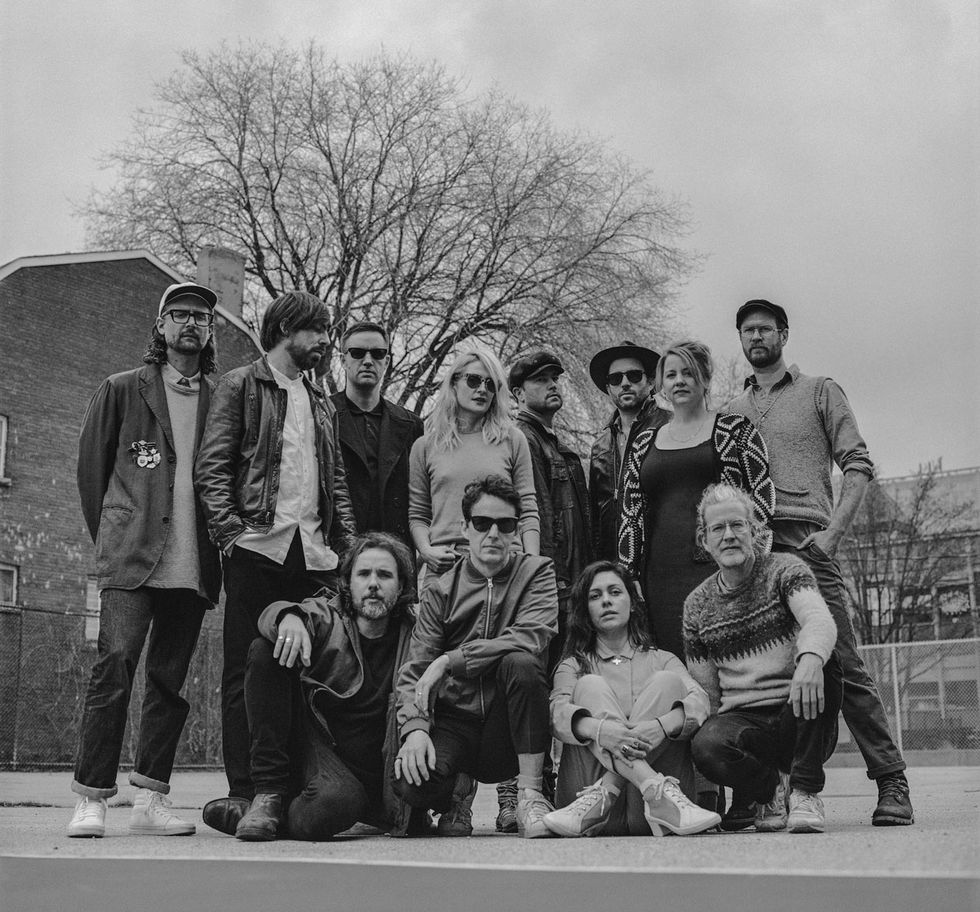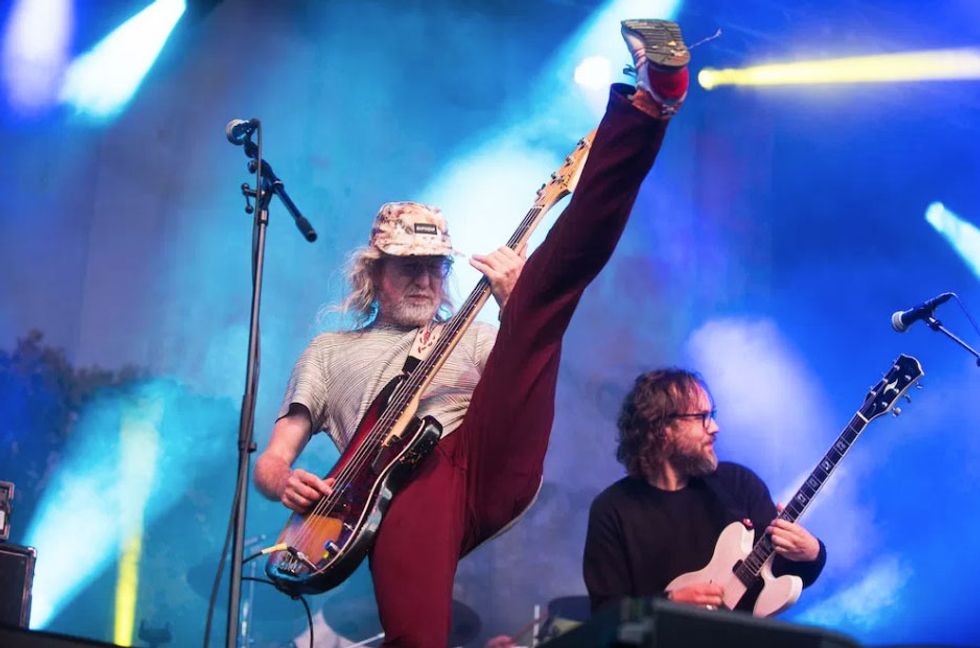To say Broken Social Scene isn’t your typical band is an understatement. They’re not just a tight-knit group of musicians pursuing the common goal of creating great music—they’ve also got nearly 20 members ... sometimes. See, things are never simple with BSS. Formed in Toronto in 2001 by frontman Kevin Drew and bassist Brendan Canning, the project was initially more of a creative outlet away from the stress of being in other bands. But the duo quickly added guitarist Charles Spearin, while also welcoming contributions from members of fellow Canadian bands such as Metric and Stars. And that was just the beginning. Soon, the band stopped looking like a band and more like, well, a social scene.
By their second album, 2002’s You Forgot It in People, BSS had created a dense sonic signature built from musical input from a wide cast of contributors that come and go from the band at any given time. “It’s really interesting when I listen to other bands,” admits Canning. “I’ll be like, ‘Oh, yeah, it sounds like such a simple thought that’s coming across here.’ With Broken, it’s definitely not just a simple idea sometimes.”
But after recording four albums (and scoring a couple of Juno Awards along the way), the Toronto collective needed a break. Years of living in close quarters and the creative compromises inherent in writing with so many people had begun to take a toll.
Many members yearned to focus on other projects. “It’s almost painful when you have a vision for a song,” says Spearin, “and then everybody gets involved and starts steering it into new directions.”
So the members went their own ways after 2010’s Forgiveness Rock Record. Some put their energy into producing other artists, while others wrote and recorded their own material. But eventually the urge to bring the ever-evolving musical crew back together became too great. After a few successful reunion performances, Broken Social Scene decided to officially shake off the dust.
With the release of this year’s Hug of Thunder, the band has circled the wagons to continue its legacy. From the ethereal pop of the album’s title track to the mid-’90s industrial feel of “Vanity Pail Kids,” Hug of Thunder covers a lot of territory. In fact, when asked to explain the band’s sound, Canning found it easier to describe what they’re not. “We’re not the same as Wilco and we’re not the same as the National. We’re not the Flaming Lips and we’re not Dinosaur Jr., but we still fit in somewhere around there.” Though the band’s collective muse may be running in a million directions at once, both Canning and Spearin echoed that there’s one thing Broken Social Scene is for certain: a family.
Broken Social Scene is a very unique situation. How did it all come together originally?
Brendan Canning: I grew up in the ’90s, playing in a couple bands that were always chasing “it.” I mean, I was part of that band Len, who sang [the 1999 hit] “Steal My Sunshine.” But I just wanted to make some basement music with Kevin Drew on a 1/4” [tape] 8-track. We were just trying to make cool late-night music. That was our first album, [2001’s] Feel Good Lost. Slowly but surely, we started playing shows where there was a revolving cast of musicians. That’s basically it—just a bunch of friends playing music and trying not to get too bogged down.
Charles, what was your introduction to the band?
Charles Spearin: When Kevin and Brendan did the first Broken Social Scene recording, I was in another band with Kevin called KC Accidental. So I ended up mixing their record. KC Accidental already had a lot of players. We played with Emily [Haines] and James [Shaw] from Metric, even though Metric wasn’t a band yet, and Amy [Millan] and Evan [Cranley] from Stars, even though Stars wasn’t a band. So really, Broken Social Scene was kind of a blend of those two bands.
How do you see your individual roles in the band?
Canning: I’m kind of known as a bass player, but I play lots of shows where I’m on guitar more—but then I’ll be back in keyboard world, too. Sometimes I’ll even take a lead on a song or two, depending on the night. But everyone likes to play bass in this band. There’s, like, five different bass players in the band. Everyone loves to play bass, because you get to direct traffic in a certain way that guitar doesn’t.
Guitar is the traffic.
Canning: Yeah, exactly! “Hey, move out of the fucking way—there’s two other cars coming in the left lane!” [Laughs.]
Charles, you primarily play guitar but handle a lot of different roles.
Spearin: I do. I play guitar, bass, trumpet, and keyboards occasionally, although I would never call myself a keyboardist. But the guitar is my main instrument. And I’ve been very heavily involved with the writing of the music and the production since the beginning.

Hug of Thunder is the band's fifth studio album and it was released by the Arts & Crafts record label on July 7, 2017.
As a writer of such sonically dense music, how do you decide who plays what?
Spearin: We don’t generally start with a core progression. It’s more like everybody has their melody that they add to the pot. And often, I don’t even know what the core progression for the song is. I don’t know what the other guitar players are really doing. We’ve just managed to fit our pieces in a jigsaw puzzle.
How do you pull off such a layered sound live?
Canning: We’ve made our bread and butter on people knowing they’re going to get a well-oiled machine that doesn’t mind being a little loose around the edges. We’re not playing to a click track or anything like that—we’re a rock ’n’ roll band. I mean, yeah, there are certain parts of the song you want to hear because they’re the hook of the song. But at the same time, you’ve got to let songs grow a little bit.
With touring and recording, the band is very much a collective. What about writing?
Canning: It’s really a song-by-song case. Whoever’s around, whoever’s got the good idea, all the songs are going to have different stories about how they unfold. On certain songs a horn section has a strong presence. Or maybe there are different vocalists that come in, and they’re leading the track. Over the years, all the songs carried a slightly different tale.
Spearin: We let inspiration dictate the song. It’s way easier to be open-minded and let everybody else’s opinions influence the song. Once all the parts are in there, you can shuffle them around to reinvent the song. Often, it’s not until the mixing stage that you really know what the song is.
Canning: For me, it’s more exciting just to hear what gets added. We’re at our best when there’s a spark but everyone contributes. We try not to get too married to singular ideas. There’s a lot of different forces at work and we just try to keep it healthy and make it work.
Kevin Drew looks on as Brendan Canning thumps his P bass and shows off his high-kick skills.
Photo by Garbine Irizar
Do you write parts with specific members in mind?
Spearin: We write with them in mind, but we don’t write for them. We write knowing they’re going to be coming and working on the song, and that we need to leave space for them.
That must be simultaneously extremely fulfilling and potentially frustrating.
Spearin: It’s pretty great when it comes together, but you can get musical constipation when you have ideas for the song and you can’t really direct it. I think the one reason we have to take hiatuses is because, every once in a while, you really do need to steer the ship yourself.
What was the spark that brought everyone back together?
Canning: I think it was just the natural evolution of time. We did a couple festival gigs in the summer of 2015—very 11th-hour kind of gigs where the offers were decent and we thought, “Yeah, why don’t we go out and do this one show?” And then a week later, the phone rings again and we think, “Well, we did just play last week, so we’re rehearsed. Yeah, sure, let’s do it.” And that gig turns out to be really fun, too. And then some of the more sour memories just trickle away a little bit and you just think, “Oh, right, we used to enjoy getting up in front of 20,000 people and making some racket.”
Spearin: I was a little apprehensive about getting the band back together, partly because it’s tough to get excited about it when there’s no music yet. I didn’t know if it was going to be that good, honestly. You don’t want to put out a half-assed record, and you don’t want to do this for the wrong reasons. But once we started working, I really felt all the ideas were strong and I got excited about how the songs were going to turn out.
[Producer] Joe Chiccarelli has some pretty big credits to his name, including Morrissey and Frank Zappa. How did having him involved change things?
Spearin: He had tons of great stories. He’d get into some story about working with, I don’t know, one of the 10,000 people that he’s worked with, and suddenly we’re all just sitting there, laughing and not getting anything done at all. But he brings people together that way. In a way, he also forced us to stand our ground. He was really positive and had tons of energy and lots of ideas, but we never let him tell us what to do. It’s more like he just became part of the group of decision making.
Tell us about the recording process.
Canning: We bopped around a little bit. We started in Charles’ garage, which is a jam space. We’d get some ideas together, and Charles would mix some demos. And then we would send the demos to Joe. Then we set up a little portable studio here at my house and chipped away like that for a little bit. We also worked in Montreal, Kevin did some of his vocals in Los Angeles, and we went back to Charles’ garage. And then we mixed it in L.A. and mastered it in New York. So we used, like, five studios. It can be a very strange process, but when the button’s recording, everyone is playing heads-up ball. You just open your ears, open your heart, and try and write a fucking tune.
Spearin: I feel like most of it was done at the Bathouse in Kingston [Ontario], and that’s just a beautiful place to write and record music. It’s not really set up as a recording studio with an isolation booth and everything like that. It’s just really a big, old house, with a lot of good gear in it. It’s a bit of a playground in terms of instruments. There’s lots of guitars, basses, pianos, organs, and old amplifiers. So, it was great to mix and match and try to find the right tones.
Charles Spearin’s Gear
GuitarsSilvertone U1
Custom aluminum T-style
Amps
Traynor Guitar Mate
Vox AC30 (when overseas)
Effects
EarthQuaker Devices Talons
EarthQuaker Devices Monarch
Ibanez Tube Screamer
Eventide PitchFactor
TC Electronic Hall of Fame Reverb
Strings and Picks
D’Addario .011–.048 sets
Dunlop Tortex .88 mm picks
Brendan Canning’s Gear
Basses1973 Fender Precision
Amps
1972 Ampeg Silverface SVT
Ampeg SVT 8x10 cabinet
Effects
Ibanez Tube Screamer
Strings and Picks
D’Addario .045/.050–105 sets
Dunlop Tortex .88 mm and .73 mm picks
What gear did you wind up gravitating toward?
Canning: I’m kind of a whatever-is-around kind of guitar player. I mean, I like playing the [Gibson] Chet Atkins that Andrew [Whiteman] has—it’s got a nice Bigsby tremolo on it. Charlie’s got a Danelectro that I like playing. And Kevin loves his Vox guitars. I didn’t like them at first—I even smashed one at a festival in San Francisco. He was pissed about that [laughs]. But they sound pretty good, I have to say. I’ve got a ’67 J-45 acoustic. I’ve got a Daddy Mojo custom guitar. I’ve got an Ibanez Firebird, a Gibson [ES-]345, another old Tele. As far as amps, I have a Traynor Guitar Mate and an old Gibson Kalamazoo amp. I have a pretty modest guitar collection—I don’t have a bunch of stuff.
Did you experiment with pedals?
Canning: We’ve been through a bunch of phases of pedals, because those green Line 6 delays [the DL4 Delay Modeler] definitely got a lot of mileage from the early days. There’s also a fuzz sound. There’s an Electro-Harmonix 16-Second Digital Delay. When we first started out, we were using these Boomerang [Phrase Sampler] pedals. I was like, “Oh, looping pedal—I can do so many things!” Now we have the [TC Electronic] Ditto, and I’ve been using that one a lot. We’ve also been using a lot of the EarthQuaker [Devices] pedals, which we really like. The Interstellar Orbiter, the Grand Orbiter. On the shelf right now, there’s a Disaster Transport and a Dispatch Master—that one’s been really good.
Spearin: The [EarthQuaker] Monarch and Talons are really great pedals, too. The Ibanez Tube Screamer is the one that’s been in our pedal chain forever. It works really well with the guitars, and we use it on bass a lot. The Eventide harmonizer [PitchFactor] was an effect that we used a lot. And I like the TC Electronic [Hall of Fame] reverb.
What about your live rigs?
Canning: For bass, it’s pretty simple. It’s a ’73 P bass. It’s your Ampeg SVT Classic. It’s your 8x10 cab. The classic bass rig. Pedals are just an Ibanez distortion pedal.
Spearin: I have a copper Silvertone that’s probably from 1957—something like that. And that guitar, I just play it forever. That’s really my baby. But the neck was starting to go, so I bought another one exactly the same. So, now I have two 1957 coppertop Silvertone guitars that are my favorite. That, with the Traynor Guitar Mate, is the combination I use a lot. I also have an aluminum Telecaster which is made by a guy in Toronto, and it’s pretty great. In terms of amps, I love the old amps with tiny speakers. They have such a boxy sound that really works well with the guitar. If you take a small amplifier with an 8" speaker, you can EQ it to get some really beautiful character and driven sounds.
Before we go, can you talk a little bit about what it’s like thinking back to how far the band has come, from a few friends in a basement working on an 8-track recording, to now?
Spearin: Well, for one thing, I’m thrilled. I like to do that—go back to my 20-year-old self and look at what’s going on in my life. And to be honest, I’m super proud of everybody involved. It was a funny moment when we were backstage at the Stephen Colbert show [Editor’s note: BBS played CBS’s The Late Show with Stephen Colbert on March 30, 2017], and we had the whole reunion of the gang. We were talking about the old gigs, playing for 35 people in funny little restaurants in Toronto, and stuff like that. It warms my heart to think about how we’ve grown and are still together.
YouTube It
Witness the harmonious wall of sound emanating from a 10-plus-member version of Broken Social Scene during this reunion performance of the lead single from Hug of Thunder on The Late Show with Stephen Colbert.
















![Rig Rundown: Russian Circles’ Mike Sullivan [2025]](https://www.premierguitar.com/media-library/youtube.jpg?id=62303631&width=1245&height=700&quality=70&coordinates=0%2C0%2C0%2C0)
















![Rig Rundown: AFI [2025]](https://www.premierguitar.com/media-library/youtube.jpg?id=62064741&width=1245&height=700&quality=70&coordinates=0%2C0%2C0%2C0)




















 Zach loves his Sovtek Mig 60 head, which he plays through a cab he built himself at a pipe-organ shop in Denver. Every glue joint is lined with thin leather for maximum air tightness, and it’s stocked with Celestion G12M Greenback speakers.
Zach loves his Sovtek Mig 60 head, which he plays through a cab he built himself at a pipe-organ shop in Denver. Every glue joint is lined with thin leather for maximum air tightness, and it’s stocked with Celestion G12M Greenback speakers.






